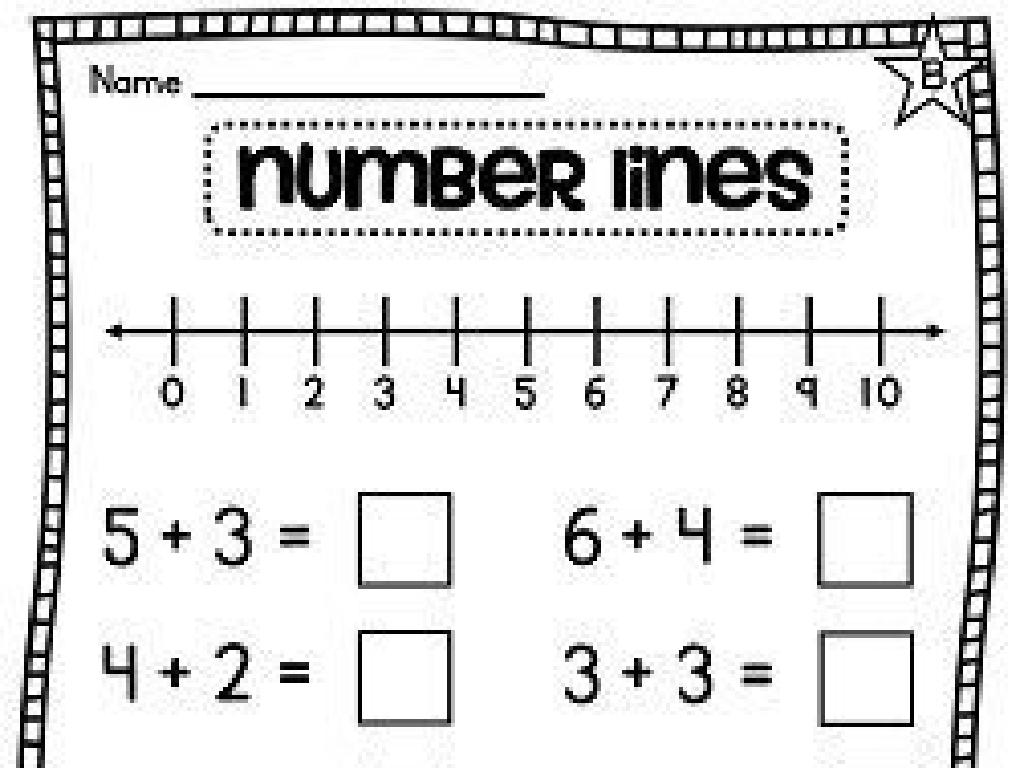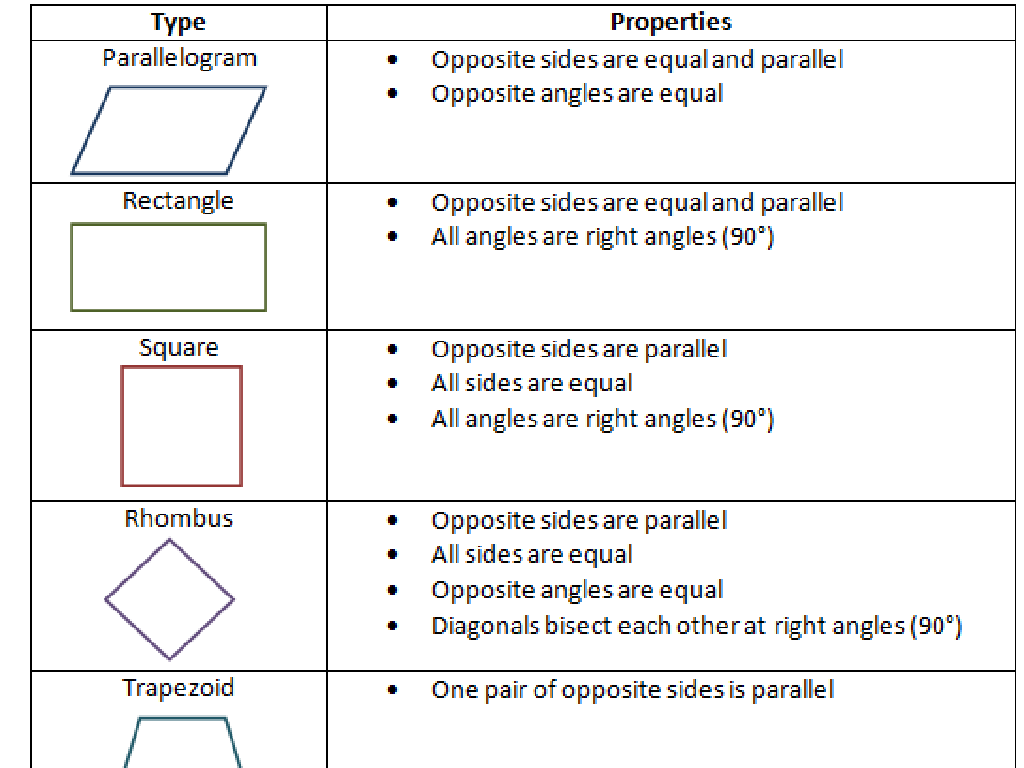Parallel, Perpendicular, And Intersecting Lines
Subject: Math
Grade: Seventh grade
Topic: Lines And Angles
Please LOG IN to download the presentation. Access is available to registered users only.
View More Content
Exploring Lines and Angles
– Geometry: Lines and angles basics
– Defining lines and angles
– Lines are straight with no curves, angles are formed when two lines meet
– Types of lines: Parallel, Perpendicular, Intersecting
– Parallel lines never meet, perpendicular lines form a right angle, intersecting lines cross each other
– Today’s focus: Understanding these lines
|
Begin the lesson by introducing the fundamental concepts of geometry, focusing on lines and angles. Explain that lines are straight paths that extend infinitely in both directions and have no thickness, while angles are formed when two lines meet at a point. Then, transition to the specific types of lines that will be the focus of today’s lesson: parallel, perpendicular, and intersecting lines. Parallel lines run alongside each other at a constant distance apart and never meet. Perpendicular lines intersect at a 90-degree angle, forming a right angle. Intersecting lines cross each other at some point. Use diagrams to visually represent each type of line. Encourage students to think of real-world examples of each type of line to help solidify their understanding.
Exploring Parallel Lines
– Define parallel lines
– Lines in a plane that never meet, no matter how far they extend
– Characteristics of parallel lines
– They have the same slope; equidistant at all points
– Real-life examples of parallel lines
– Railroad tracks, edges of notebook paper
|
This slide introduces the concept of parallel lines to seventh-grade students. Begin with the definition, emphasizing that parallel lines are straight lines in the same plane that do not intersect. Highlight the characteristics, such as having identical slopes and being equidistant from each other at all points. Use tangible examples like railroad tracks and the edges of notebook paper to help students visualize and relate to the concept in their everyday lives. Encourage students to think of other examples they may encounter daily. This foundational understanding will be crucial as they progress in their study of geometry and spatial reasoning.
Identifying Parallel Lines
– Recognizing parallel lines in shapes
– Look for lines that never meet, no matter how far they extend
– Symbols denoting parallel lines
– Parallel lines are marked with arrow symbols on each line
– Practice finding parallel lines
– Use the provided figures to identify all sets of parallel lines
|
This slide is aimed at teaching students how to identify parallel lines within various shapes. Start by explaining that parallel lines are lines in a plane that do not meet; they are always the same distance apart and run in the same direction. Show the students how mathematicians use arrows to denote parallel lines in diagrams. For the practice activity, provide students with a series of figures and ask them to find and mark all the parallel lines. Encourage them to use the symbols they’ve learned to denote which lines are parallel. This exercise will help solidify their understanding of parallel lines and how to visually identify them in geometric figures.
Exploring Perpendicular Lines
– Define perpendicular lines
– Two lines that intersect to form right angles
– Properties of perpendicular lines
– They meet at 90 degrees and form four right angles
– Perpendicular lines in the environment
– Examples: street intersections, window corners
– Understanding through examples
– Practice by identifying perpendicular lines in class
|
This slide introduces the concept of perpendicular lines, which are lines that intersect at right angles (90 degrees). Emphasize the importance of the right angle in identifying perpendicular lines. Discuss properties such as the equal angles formed. Show real-life examples like crossroads or the edges of a book to help students recognize these lines in their surroundings. Encourage students to bring in pictures or point out perpendicular lines they see around the school or at home. This will help them connect the mathematical concept to the real world and understand its practical applications.
Creating Perpendicular Lines
– Use a protractor for drawing
– Place the protractor’s center at the line’s endpoint
– Activity: Draw perpendicular lines
– Use a straight edge to draw two lines intersecting at a right angle
– Check your lines for perpendicularity
– Measure each angle to ensure it’s 90 degrees
– Understand 90-degree angles
– Perpendicular lines form a perfect ‘L’ shape
|
This slide introduces the concept of creating perpendicular lines, which are lines that intersect at a 90-degree angle. Start by demonstrating how to use a protractor to measure and draw a 90-degree angle. For the class activity, provide students with protractors and have them practice drawing perpendicular lines on graph paper. Encourage them to check their work by measuring the angles. Emphasize that perpendicular lines always meet to form right angles, which look like the corner of a square or the letter ‘L’. This exercise will help students recognize and construct perpendicular lines, a fundamental skill in geometry.
Exploring Intersecting Lines
– Define intersecting lines
– Lines that cross at a single point
– Intersecting lines create angles
– The point of intersection forms angles
– Identify intersecting lines in objects
– Look at ‘X’ shape in scissors, or street crossings
– Understanding angles formed
– Acute, right, obtuse angles can be formed
|
This slide introduces the concept of intersecting lines, which are lines that meet or cross at a single point. Emphasize that when two lines intersect, they create angles at the point of intersection. Encourage students to identify intersecting lines in everyday objects, such as the blades of a pair of scissors or the layout of streets in a city. Discuss the types of angles formed by intersecting lines, including acute, right, and obtuse angles, and how to recognize them. This will help students understand the practical applications of intersecting lines and angles in the real world.
Angles Formed by Intersecting Lines
– How to name intersecting angles
– Use vertex and ray points to name angles, e.g., ABC
– Measuring angles using a protractor
– Place the protractor’s center on the vertex, align a ray with the baseline, and read the measurement where the second ray crosses the scale.
– Practice measuring and labeling
– Find angles in diagrams and label with correct measurements.
– Understanding angle relationships
|
This slide introduces students to the concept of angles formed by intersecting lines. Start by explaining the naming convention for angles, using the vertex and the points on the rays to create a name like ABC. Demonstrate how to measure angles with a protractor, ensuring students understand how to align it correctly and read the scale. Provide practice opportunities with diagrams of intersecting lines, asking students to measure and label the angles. Discuss the types of angles formed, such as acute, obtuse, and right angles, and how they relate to each other. Encourage students to ask questions and provide assistance as needed during the practice activity.
Class Activity: Exploring Lines and Angles
– Find classroom line examples
– Create a poster with examples
– Draw or take pictures of parallel, perpendicular, and intersecting lines found
– Include drawings and photos
– Present findings to class
– Explain your examples and what you learned
|
This group activity is designed to help students identify and understand parallel, perpendicular, and intersecting lines in a practical, hands-on way. Divide the class into small groups and instruct them to look around the classroom and school environment to find real-life examples of each type of line. They should then create a poster that includes both drawings and photographs of these lines, clearly labeling each type. Encourage creativity and accurate representation. Each group will present their poster to the class, explaining the examples they found and discussing the properties of the lines shown. For the teacher: Prepare a list of potential places where students can find these lines, ensure they have materials for the poster, and guide them on how to safely take photos if necessary.
Lines and Angles: Review and Quiz
– Recap key concepts briefly
– Pop quiz on line types
– Identify parallel, perpendicular, or intersecting lines in figures
– Class discussion of quiz answers
– Discuss why each answer is correct, fostering peer learning
– Reinforce learning outcomes
|
This slide is aimed at reviewing the concepts of parallel, perpendicular, and intersecting lines. Start with a quick recap of the definitions and properties of each type of line. Then, move on to a pop quiz where students will be shown figures and asked to identify the type of lines depicted. After the quiz, discuss the answers as a class to ensure understanding and clear up any misconceptions. This interactive approach helps reinforce the material and assess students’ grasp of the topic. Encourage students to explain their reasoning during the discussion to enhance their critical thinking skills.
Homework: Lines and Angles Mastery
– Practice identifying line types
– Find examples of parallel, perpendicular, and intersecting lines in your environment.
– Draw parallel, perpendicular lines
– Use a ruler to ensure your lines are straight and accurately represented.
– Complete the worksheet provided
– The worksheet reinforces today’s lesson and prepares you for the quiz.
– Introduction to triangles preview
– Next class, we’ll explore how these lines form different types of triangles.
|
This homework assignment is designed to reinforce students’ understanding of parallel, perpendicular, and intersecting lines. Encourage students to look for real-world examples of these lines to help them visualize the concepts. Provide clear instructions on how to use a ruler to draw accurate representations of each type of line. The worksheet should be a mix of identification and drawing exercises to cater to different learning styles. Lastly, give a brief introduction to triangles to pique students’ interest for the next lesson. This will help them understand how lines and angles form the basis for studying more complex shapes.





